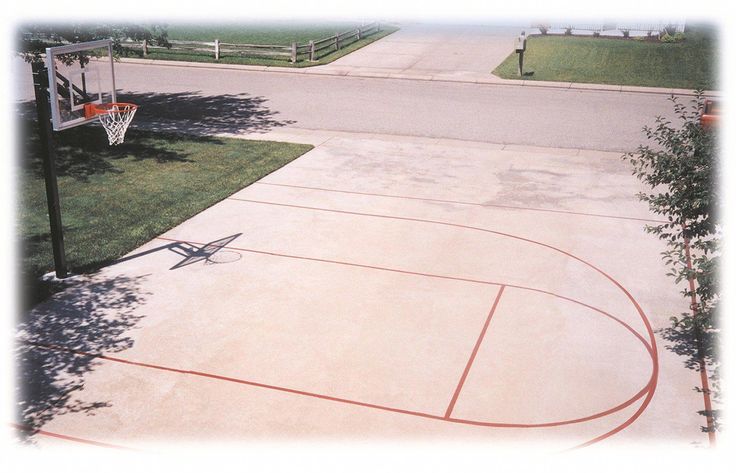Home »
Misc »
How to paint the lines on a basketball court
How to paint the lines on a basketball court
How to Paint a Basketball Court
Most hoop lovers are content with a full court to play in, but most will agree that it’s a different feeling when you play in a good-looking court. Not only will it prolong your sneakers’ life span, paint and design on a basketball can inspire spirit and pride. What’s more, it also boosts teams’ morale, and for designs inherent to a community, it does give your place an identity. This article will provide you with tips and tricks on how to paint a basketball court and more.
What Materials are Used to Paint a Basketball Court?Both indoor and outdoor basketball courts are subject to a lot of wear and tear. So at some point, you will have to replace or redesign how the floor looks. For wooden floors or wood tiles used in outdoor gyms, you won’t need to replace them as often. The same cannot be said, though, about outdoor courts.
Outdoor basketball courts are subjected to heat, rain, snow, and everything in between. In extreme conditions, paint should be reapplied every couple of months or so.![]() Most experts recommend acrylic paint to finish an outdoor basketball court. What are some of the reasons acrylic is the best type of paint to use for basketball courts?
Most experts recommend acrylic paint to finish an outdoor basketball court. What are some of the reasons acrylic is the best type of paint to use for basketball courts?
Perhaps the most important reason is that acrylic is made with specially-graded silica sand that prevents slippage. A slippery basketball court because of poor choices in the type of paint can be perilous and may cause injuries. Applying acrylic paint court surfaces make them aesthetically very pleasing while being easy to construct and maintain. Additionally, acrylic paint is resistant to common chemicals.
For other materials to paint a basketball court, you will need rollers (4 inches and 9 inches), pads, and trays. You may also need assorted art brushes, paint can opener, latex gloves, paint cups, duct tape, painter’s tape, and caution tape. During the project, you may need a water hose, pencil or chalk, and measuring tape.
What Kind of Paint Do You Use on a Basketball Court?As pointed out earlier, the most recommended type of paint for outdoor basketball courts is acrylic.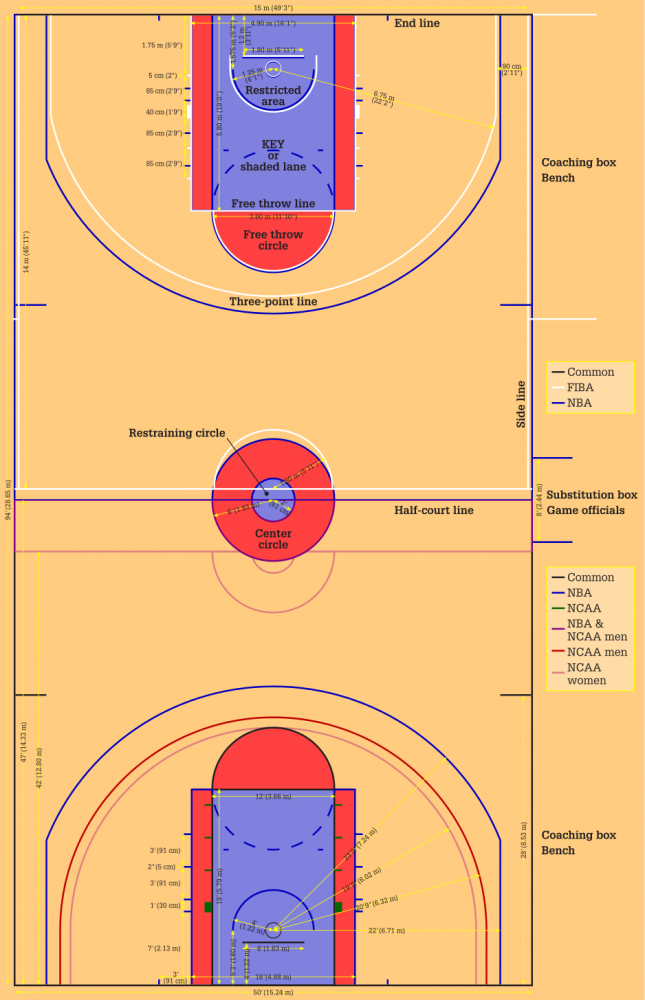 Acrylic has some properties that make it best for traction while adding to the basketball floor’s aesthetic value. What’s more, acrylic is essentially fade-resistant, easy to repair, waterproof, and highly durable.
Acrylic has some properties that make it best for traction while adding to the basketball floor’s aesthetic value. What’s more, acrylic is essentially fade-resistant, easy to repair, waterproof, and highly durable.
Now, there are other kinds of paint that you may use on a basketball court. Some may suggest rubberized paint for concrete basketball courts or perhaps epoxy paint. Generally, both rubberized and epoxy paint are considerably more expensive than acrylic paint, so the latter is more popular as paint used in a basketball court.
How Do You Paint a Three-point Line on a Basketball Court?Marking and painting the three-point line is one of the more difficult paint jobs you can do on the basketball court. The three-point line is long and shaped like an arc, so it’s easy to mess up if you don’t know how to go about with it.
The first thing that you need to do is look up the dimensions of the three-point line. It would be up to you to adopt the regulation distance of the three-point line, whether the high-school, college, or pro dimensions.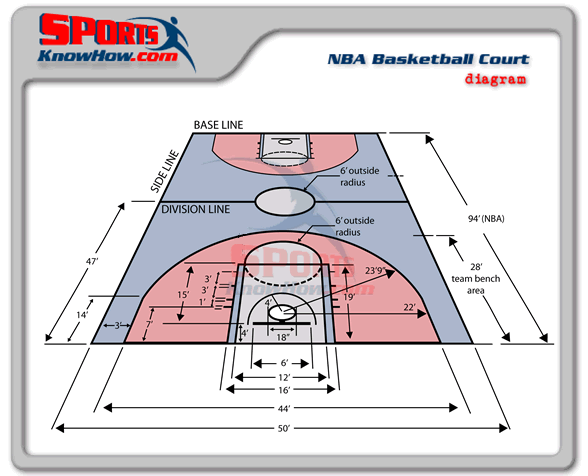
After determining the dimensions, the next thing you need to do is to create a makeshift compass. One method of doing it, and perhaps the easiest, is grabbing a string. One end should be at the bottom of the basket and have someone hold the other end with chalk. Drag the chalk with the string across to mark the three-point line. You can paint the line with acrylic paint by merely following the chalk lines.
In the NBA, the three-point line does not have the same distance all around. If you want to simulate an NBA three-point line’s appearance, it will be a little bit more complicated than just tracing an arc from one corner to the other.
What is the Best Surface for Outdoor Basketball Court?If we are talking about outdoor basketball courts, two surfaces are preferred– concrete and asphalt. Other options for the base material for an outdoor basketball court are crushed stone and modular bases. With that being said, most outdoor basketball courts are either concrete and asphalt.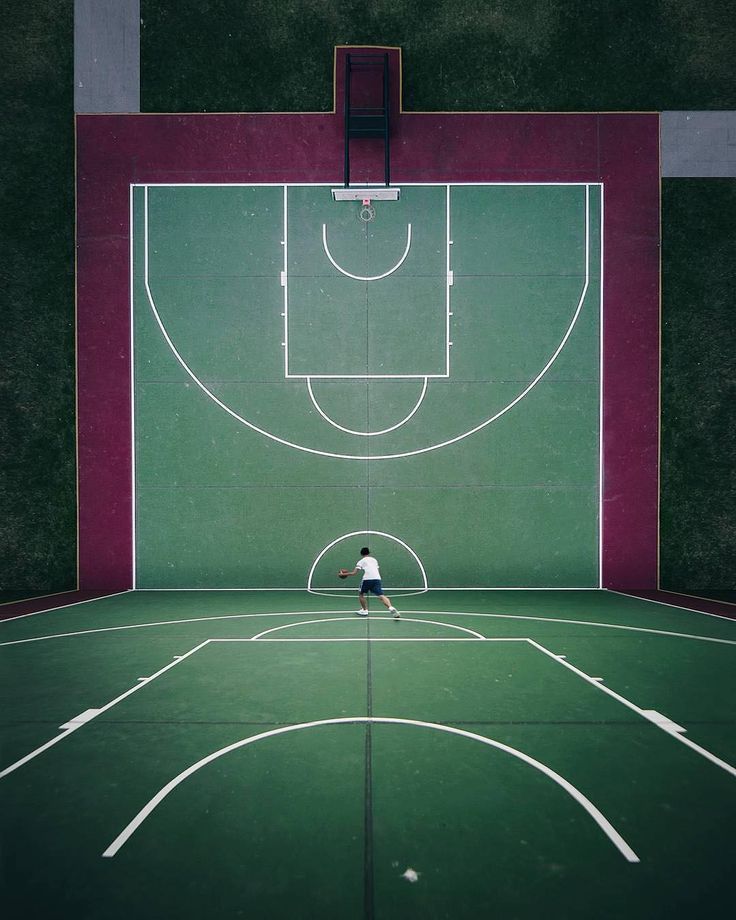
Honestly, it would boil down to personal preference in choosing between the two. In most cases, concrete is the better choice if you consider the cost of maintenance and repair. When done right, a concrete base material for a basketball court is basically maintenance-free. On the other hand, asphalt will deteriorate over time considering the freeze/that cycles, but unlike concrete, it is less likely to sustain cracks.
Now, how do you decide whether to go for concrete or asphalt? It depends on several factors. Relatively, both concrete and asphalt are incredibly strong surfaces, with the former potentially lasting 40 years with proper care and the latter for around 15-20 years. Other factors that contribute to the durability are proper application, thickness, and supporting materials.
As for appearance and functionality, asphalt provides an even surface than concrete. It would also be easier for the joints since it is not as hard as concrete. On the other hand, concrete is essentially non-slip. As we have pointed out, deciding which one is better comes down to personal preference.
As we have pointed out, deciding which one is better comes down to personal preference.
As it stands, whether you choose to have a concrete or asphalt base material or surface, both will require upkeep to lengthen its service years. Resurfacing the material at least once a year may help prevent holes and cracks from developing, thereby lessening the risk for injuries. Sealcoating will also help the weather or rough play from ruining the surface, and applying sealant provide moisture resistance, reducing the need for repairs in the long run.
Here is a rundown of the differences between a concrete and an asphalt surface basketball court:
- Asphalt is the cheaper option than concrete.
- Concrete is more challenging to install than asphalt.
- Asphalt does not last as long as concrete, more so if it’s not correctly built and installed.
- An asphalt surface is more even and softer than concrete, which makes it easier for the joints.
- Post-tension concrete basketball courts are a type of concrete that adjusts to tension to prevent cracks.
 While that is way more expensive, it may be one of the smartest choices as an outdoor basketball court surface.
While that is way more expensive, it may be one of the smartest choices as an outdoor basketball court surface.
Additionally, there is a considerable difference in using premium acrylic paint and its standard counterparts. The standard acrylic paint typically has a 1-year warranty while the premium has up to five years. However, the most significant difference is that the premium acrylic paint has a life expectancy of up to 30 years compared to the standard’s five years.
What’s the Average Cost to Paint a Basketball Court?Like any construction project, the cost of painting a basketball court depends on several factors. Naturally, the bigger the court is, the more expensive the project. How much does it cost to paint a basketball court? A generous estimate, which means at the low end of the spectrum, may cost around $16,000, including the installation of the hoop.
However, not many of us can afford to hire a contractor to do the work. That is why when you consider how much it costs to paint a basketball court, it would be better off to do it yourself than hire someone to do it for you.
If you or the community already have a basketball court in place, you will save a lot of money doing the project yourselves. At most, you will only need to buy $100 worth of top-notch acrylic paint, or even as low as $50 for acrylic paints with lesser quality. There will be other expenses thrown here or there (like tapes and markers), but that still dwarfs the cost of hiring a contractor to do the job.
5 Tips on How to Paint a Basketball Court1. To ensure that the entire project goes smoothly, pay attention to smaller details such as the materials and how you want the court to look. Sort the materials, piling them by how similar the items are. If you can, make a diagram to follow the pattern that you’d like as to the appearance of the basketball court.
2. Before applying the primer, make sure you wash the whole basketball court clean with a power washer and a broom. If you don’t have access to a power washer, a hose with a powered nozzle will do. Broom the court afterward to make sure it is clean and let the surface dry completely.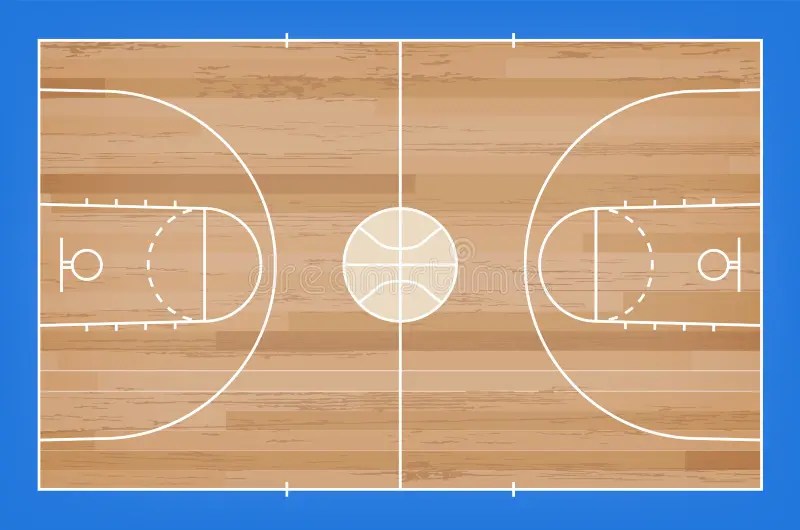 Drying time may vary depending on the temperature and humidity. This is not the time to be impatient.
Drying time may vary depending on the temperature and humidity. This is not the time to be impatient.
3. After the area dries completely, apply a clear primer to the surface. Use rollers to do this.
4. If you want to take it to the next level and paint some center court logo design, we recommend making a stencil out of poster board. Trace the outline over the poster board and cut out certain sections. Another method uses the grid system where you use the grid or squares as a guide for sketching the image. This is not for everyone, but if you have an artist in your midst, it’s worth a try.
5. Paint the lane in a different color than the lines to add that authentic look and feel. And remember, basketball lines are approximately two inches wide, so don’t vary the sideline, baseline, and centerline width.
Wrapping Things Up: How to Paint a Basketball CourtBasketball courts, whether indoor or outdoor, need retouching and a repaint every once in a while.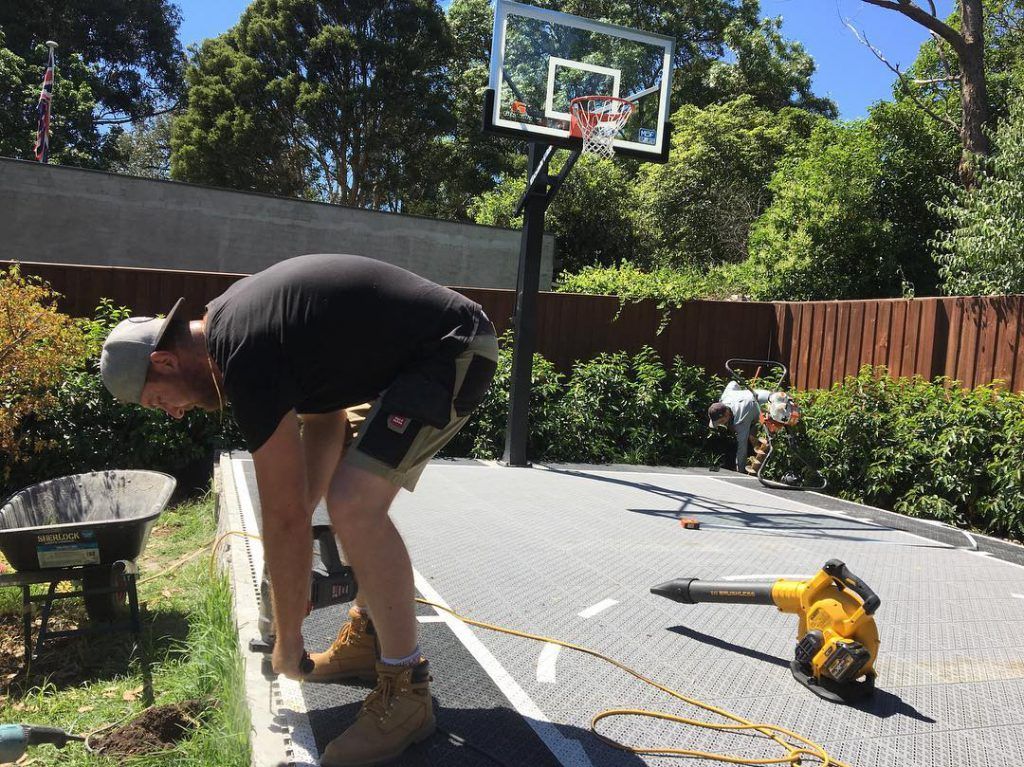 For outdoor basketball courts, repainting may come more often than the elections since these courts are subject to harsh weather.
For outdoor basketball courts, repainting may come more often than the elections since these courts are subject to harsh weather.
The most recommended type of paint for outdoor basketball courts is acrylic. Acrylic paint is made with specially-graded silica that essentially makes it slippage-free. It is also excellent to look at and is available in dozens of colors. Moreover, acrylic paint is resistant to common chemicals.
Acrylic paint is available in standard and premium variants. Standard acrylic paints cost less, but the premium alternative may be the smarter choice in the long run. It has a more extended warranty (five years compared to one) and typically outlasts its standard counterpart in terms of life expectancy (30 yrs to five yrs).
Now, when you’re given a choice between asphalt and concrete as base material or surface in an outdoor basketball court, which should you choose? Most experts would recommend concrete and rightly so.
Concrete is generally more durable and virtually a non-slip surface.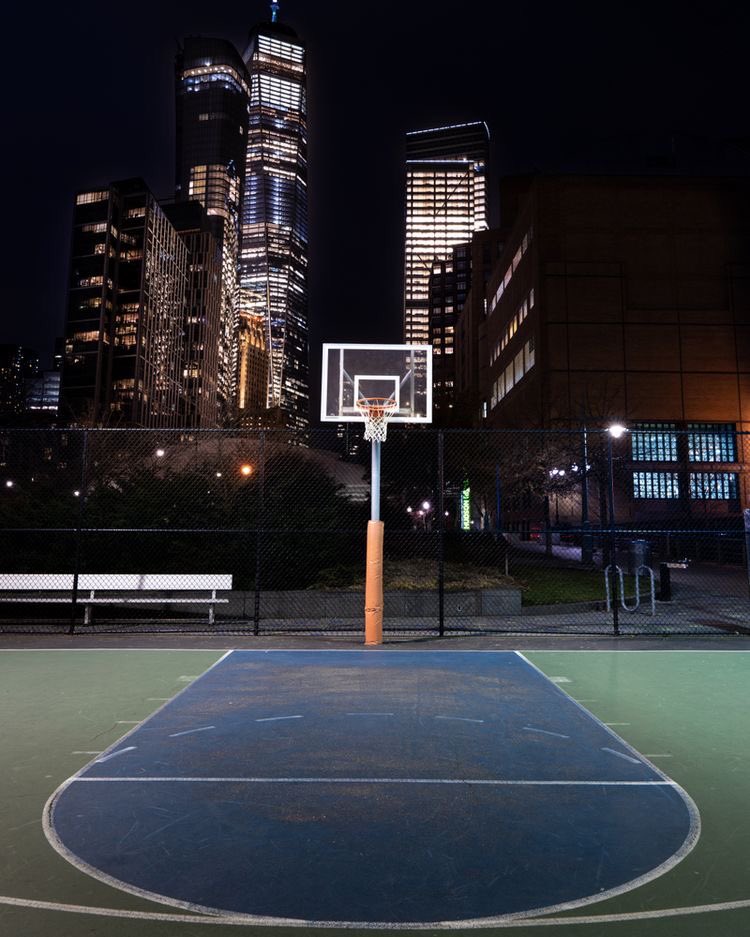 Asphalt has a more bouncy feel and typically costs less to install. However, concrete trumps asphalt when it comes to years of service because some well-built concrete surfaces may last as long as 30 years. Post-tension concrete is an even better, albeit expensive choice. This type of concrete surface “adjusts” to any tension to prevent cracks. It is definitely a smart choice, considering the amount of money you would save in the long haul.
Asphalt has a more bouncy feel and typically costs less to install. However, concrete trumps asphalt when it comes to years of service because some well-built concrete surfaces may last as long as 30 years. Post-tension concrete is an even better, albeit expensive choice. This type of concrete surface “adjusts” to any tension to prevent cracks. It is definitely a smart choice, considering the amount of money you would save in the long haul.
Well, if you had no idea how to paint a basketball court, we hope that this article pointed you in the right direction. Sometimes, these kinds of projects are not to be taken too seriously. If done with friends and the people in your community that care and love basketball, it is definitely an excellent way to build camaraderie while having fun doing manual work.
If you found this post helpful, you’re definitely going to like our other basketball FAQ articles here.
More interesting basketball FAQ posts here:
> How Many Laps Around a Basketball Court is a Mile?
> How Many Yards is a Basketball Court?
> How to Install a Ground Basketball Hoop?
> How Many Square Feet is a Basketball Court?
How to Paint a Concrete Basketball Court
Whether in your backyard or as part of a local community project, a basketball court can be a great place for staying active and having fun.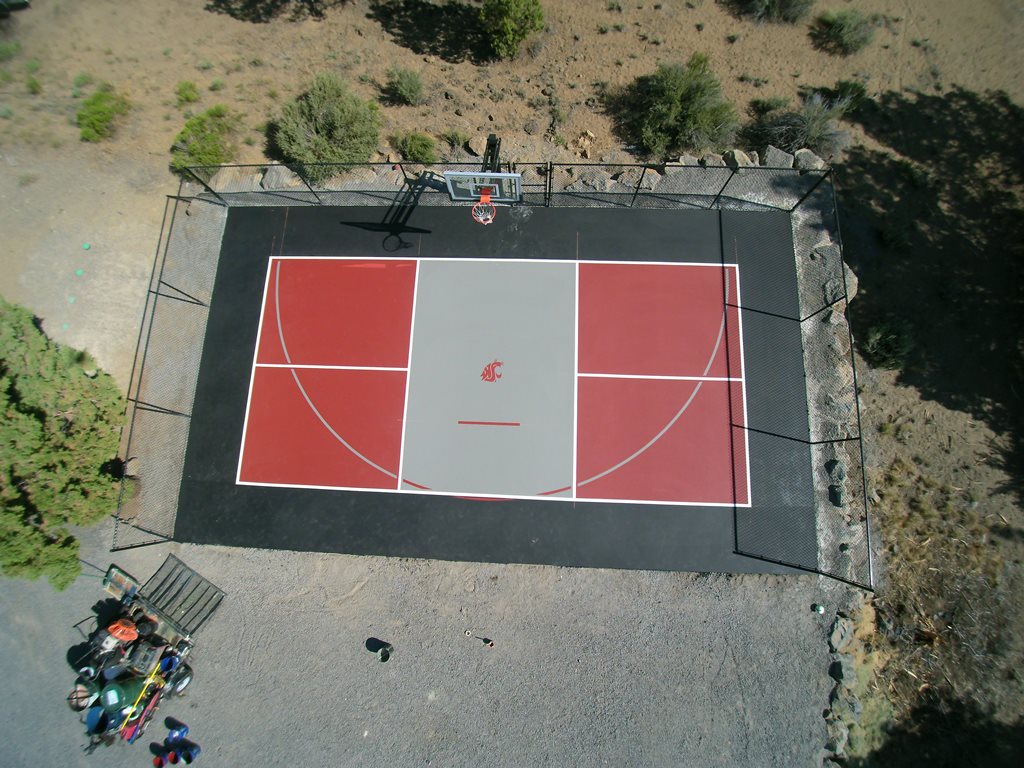 If you have an outdoor basketball court already or are looking at making one, painting it correctly is essential. Our guide will give you a rundown of exactly why you should paint a concrete basketball court. Plus why using the right concrete basketball paint is important!
If you have an outdoor basketball court already or are looking at making one, painting it correctly is essential. Our guide will give you a rundown of exactly why you should paint a concrete basketball court. Plus why using the right concrete basketball paint is important!
Do You Need Lines On A Basketball Court?One of the first things to know is why painting lines on an outdoor basketball court is so important. Paint is used to mark the edges and lines within the court to tell players where to stand and shoot from. These lines need to be clear so players can follow the rules of basketball properly. The sidelines, midcourt line, and baselines must be clear for players and spectators so the game can be played correctly.
Paying attention to the lines and measurements during painting is especially needed if you’re painting a concrete court for a basketball team. However, it’s also good to have the lines right if you’re just painting a court for your children. This will help them learn the game of basketball properly!
This will help them learn the game of basketball properly!
Why You
Should Paint A Concrete Basketball CourtBeyond marking lines on your outdoor basketball court, paint should be used to cover the whole surface of the court. In professional basketball, the NBA uses hardwood basketball courts with different types of finish to protect them. This is because the courts endure a lot of wear and tear from players running around and jumping for balls. The finish of the wood also helps with absorbing shock and bounce, leading to better performance.
Similarly, on outdoor concrete basketball courts, paint can be used to improve the durability of the court, players’ traction, and ball bounce. Painting the whole surface of your court ensures the surface is protected and makes it better for playing on. Plus, giving it a coat of paint means it will look more authentic, just like a real NBA basketball court!
How To Paint A Concrete Basketball Court?Painting a concrete basketball court is relatively easy.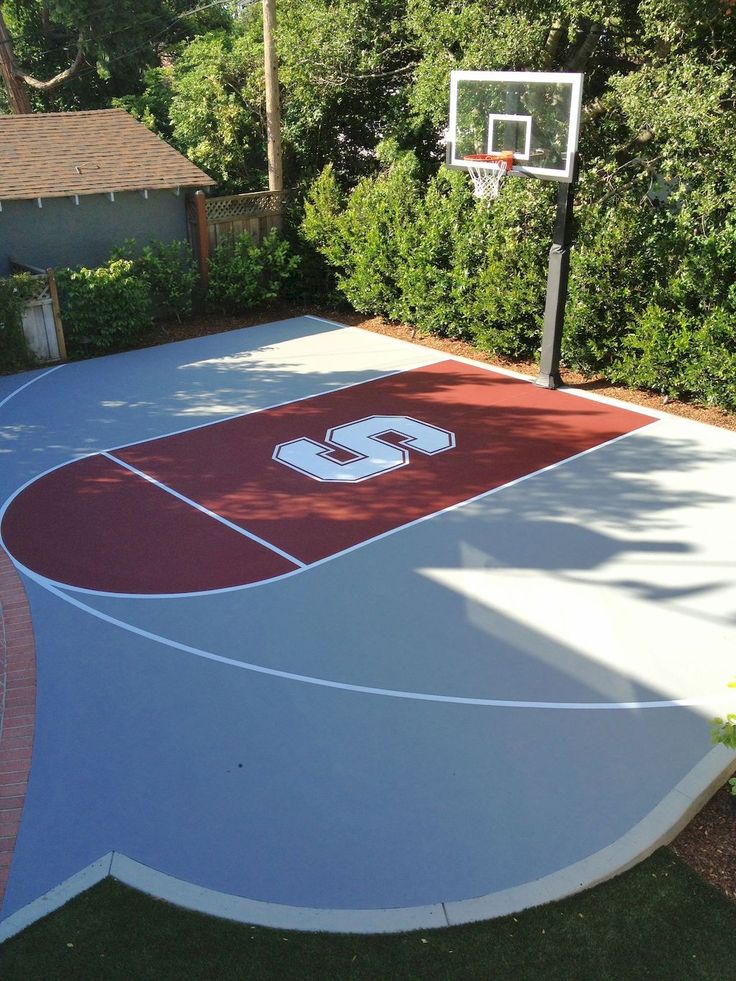 A few tips are helpful if you’ve never done it before, though!
A few tips are helpful if you’ve never done it before, though!
First, you need to prepare your court properly. Make sure the concrete is clean using a pressure washer to get up any dirt, especially if it’s an older surface. Dirt will stop the paint sticking to the concrete properly. Second, fill any cracks or gaps that may have appeared over time. Home Depot and other DIY stores sell concrete patchers to do this. This will make sure the finish is clean and professional once painted.
Preparing The Surface
Priming concrete is also key. Clear concrete primers are available from many DIY shops. When applying you should always use the appropriate clothing, skin, and eye protection. If laying a new court or resurfacing one completely, make sure the concrete has had enough time to dry before prepping and painting.
After the preparation is done, you need to measure out your basketball court lines. This can be done using simple instructions available online, which tell you the exact measurements between basketball court lines on concrete.
Choosing Your Paint
Finally, pick your paint. You must use an outdoor concrete paint, as paint does not stick to concrete unless it’s a special type. Other paints may also be slippy, which could cause injury to players or children using the court. There are many different brands of concrete basketball court paint that you can pick from. Some of these are Duracourt, Dyco’s Instacourt, and Sherwin William’s concrete sealer paint. Most DIY stores have a range of ordinary outdoor concrete paints. There also specialist basketball court paints to choose from if you require the highest specifications.
Pick whichever color you like to paint your court. There are different colors to create logos if you’re painting for a specific team or group similar to professional NBA courts. NBA courts are normally built from hardwood floors that is better for the players to run on. Typically, a basketball court is painted blue with white lines.
ConclusionPainting a concrete basketball court is quite simple when the correct preparations are taken. Taking the time to paint the basketball court and mark the basketball court lines onto the concrete will make your court much more professional and fun to play on. Putting in a little bit of work will help transform your basketball court into a great outdoor area for plenty of games!
Taking the time to paint the basketball court and mark the basketball court lines onto the concrete will make your court much more professional and fun to play on. Putting in a little bit of work will help transform your basketball court into a great outdoor area for plenty of games!
Basketball court markings: standards and norms
Author of the article
Khvatkov Dmitry
Consultant in the production of rubber coatings
Basketball field marking requirements are approved by the FIBA standard. The site must be flat with a hard surface, free of bends, cracks and other obstacles. The accepted dimensions of the field are 28 m long and 16 m wide. By NBA standards, the field is slightly larger: 28.7 m (94' ft) long and 15.3 m (50' ft) wide.
Areas not intended for international competitions may differ from accepted standards (for public use, in schools or universities, etc.) and usually vary from 20 to 28 m in length and from 12 to 16 m in width.
Basketball Court Marking Standards
Basketball court markings are conventionally divided into 5 components:
- Boundary lines. They are located along the perimeter of the site and set its size. The lines that run along the field are called side lines, and those that are behind the baskets are called front lines.
- Central line. Divides the court in half parallel to the front lines.
- Central zone. It is a circle and is placed in the middle of the center line, and, accordingly, in the center of the entire field.
- Three-point line. It is a semi-ellipse and is located around the shields on both sides of the field. It limits the close range.
- Free throw line. It is located in front of the boards parallel to the front line and is limited on the sides by paint lines.
The standard line width is 5 cm. All outlines and lines must be of the same color (usually white) and be clearly visible from anywhere on the court.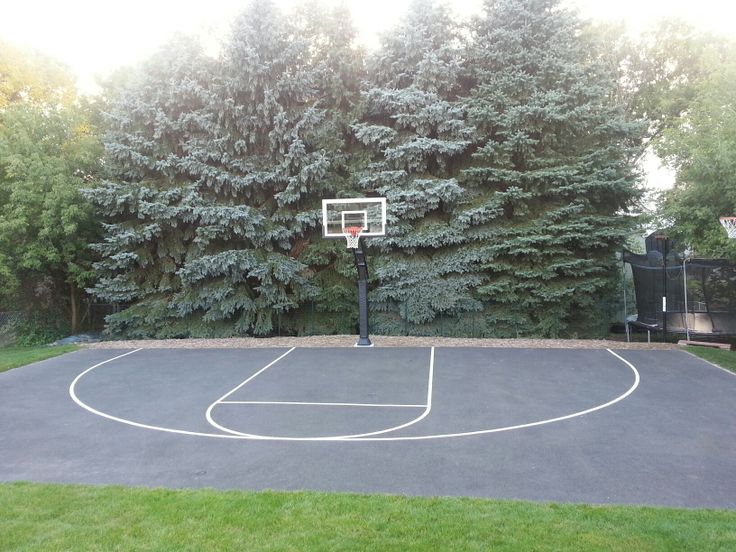
Common lines
Common lines are used to limit the playing area of the court. The side lines (along the field) according to FIBA standards should be 28 m long, and the front lines - 16 m. For public areas, deviations from the accepted standards are allowed. Typically, basketball courts in schools or gyms are made from 20 m long and 12 m wide.
Central lines
The center line is parallel to the front and divides the field exactly in half. According to the standards - it should extend beyond the side lines by 15 cm on both sides.
In the middle of the center line there is a circle with a diameter of 3.6 m, which limits the central zone of the field. In this zone, the ball is played at the beginning of the game.
Three-Point Line
Three-Point Lines are located around the backboards on both sides of the field and consist of two straight lines 2.9 long9 m and a semicircle. Straight lines run perpendicular to the front at a distance of 0.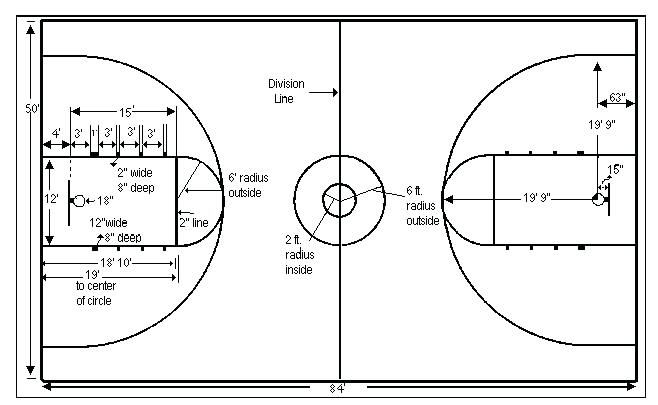 9 m from the side lines. Despite the fact that visually the distance from the ring to the side of the three-point line seems to be less than to its central part, the distance from the backboard to any point is 6.75 m.
9 m from the side lines. Despite the fact that visually the distance from the ring to the side of the three-point line seems to be less than to its central part, the distance from the backboard to any point is 6.75 m.
Penalty lines
Penalty lines limit the nearest area at the backboard. They consist of a trapezoid and a free throw zone.
Despite the name, the "trapezium" is a rectangle (until 2009year it really was a trapezoid), which is located under the shield. Its dimensions are 5.8 meters long and 4.9 meters wide. The shield is located at a distance of 1.575 m from the end line in the middle of the court. In front of the backboard, at a distance of 1.25 m, there is a semicircle that limits the area for picking up the ball.
At a distance of 4.225 meters from the backboard, the trapeze zone ends and the free throw zone begins. It is a semicircle with a diameter of 3.6 m (like the central circle).
Paint zone lines
These lines are serifs on both sides of the trapezoid (parallel to the sidelines).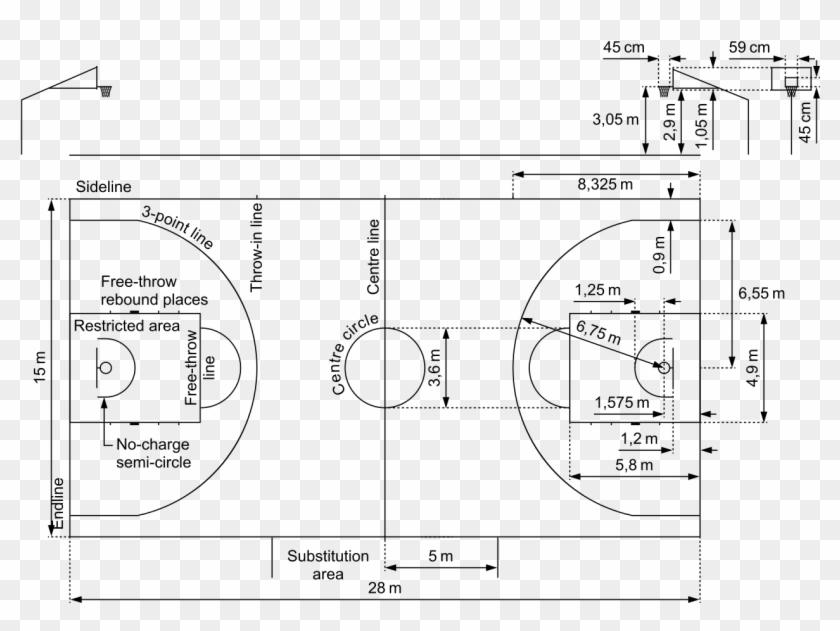 They limit the areas for players who are fighting for the ball during a free throw.
They limit the areas for players who are fighting for the ball during a free throw.
Zones on the basketball field
The basketball court is divided into zones using markings. Each zone has its own specific rules.
Center circle
The center circle is used as a separate kick-off area at the start of the game. One representative from each team stand in a circle from their side and fight for the ball in a jump, after it is dropped by the referee. All players are exclusively on their side of the field, except for one who rebounds on the opponent's side.
Neutral zone
The peculiarity of this zone is that as soon as the player of the attacking team with the ball crosses the center line and is on the side of the opponent, he cannot pass the ball to the player of his team who is on the other side of the field (i.e. behind center line on your side).
Three-point zone
The three-point line limits the near zone of the shot. Hitting the basket from outside the basket brings the team three points. If the throw was made inside the zone, then it brings two points.
If the throw was made inside the zone, then it brings two points.
Three-second zone
This is the zone in close proximity to the ring. It is called three-second, since the player of the attacking team cannot be in it for more than three seconds. Most balls are thrown in this zone, so when attacking, it provides maximum protection.
Free throw area
In controversial situations, a free throw is provided from this area. The player of the attacking team must score the ball without stepping over the line of the trapezoid. At the same time, the players of both teams are not in the three-second zone. They take up positions along the paint lines on the sides of the trapezoid and may not step outside the lines until the free throw shooter has shot the ball.
How to mark a basketball field?
Basketball field markings, whether it is an international competition court or an open-air amateur field, are best applied using special equipment. This will ensure the long life of the coating, the lines will not clog and will promote fair play.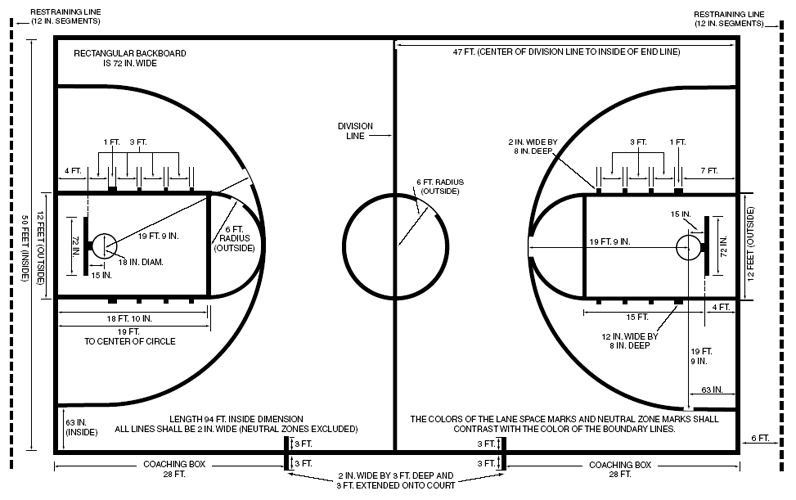
You can order the marking of a basketball court in Moscow and the Moscow region from Rezkom. We will measure the premises and develop a design project for the field so that it complies with generally accepted rules and is convenient for operation. For more details, you can contact our manager by phone 8-495-64-24-111.
how to open? How to equip it?
Each of us can create a professional basketball court. However, this will require huge financial investments, hiring specialists and a large room.
This article is written for owners of schools, sports complexes and other similar establishments. And also for parents who have a huge house or cottage. Those who want to build a basketball court in them.
We will look at all aspects of creating a field for this sport. We will tell you where to place the judges and how to draw the markings. And also about many other things.
The International Basketball Federation has created uniform requirements for all venues for this sport.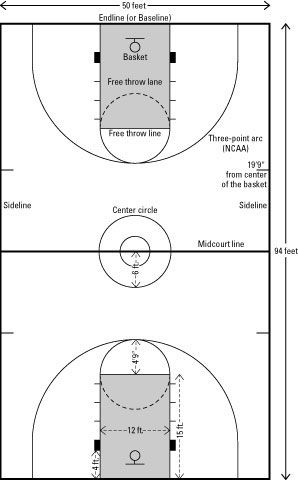 If you create a field that complies with the regulations, you will be able to hold professional competitions on it. And even rent out your space. Moreover, both for games and for tournaments.
If you create a field that complies with the regulations, you will be able to hold professional competitions on it. And even rent out your space. Moreover, both for games and for tournaments.
How large should a basketball court be? The basketball field must be made in the shape of a rectangle. It must have a hard surface. The latter can be made from wood or other materials.
The basketball court must be free from unnecessary objects. Only 2 racks should be located on it. 2 shields. 2 baskets for balls. And also markup. Chairs, benches and other things on the site should not be.
Requirements for the dimensions of the basketball court
The Basketball Federation has uniform requirements for the dimensions of the court. According to them, the field must be 28 m long and 15 m wide.
The Basketball Federation also allows competitions to be held on smaller courts. With a length of 26 m. And a width of 14 m. Competitions for young athletes can be held on such sites.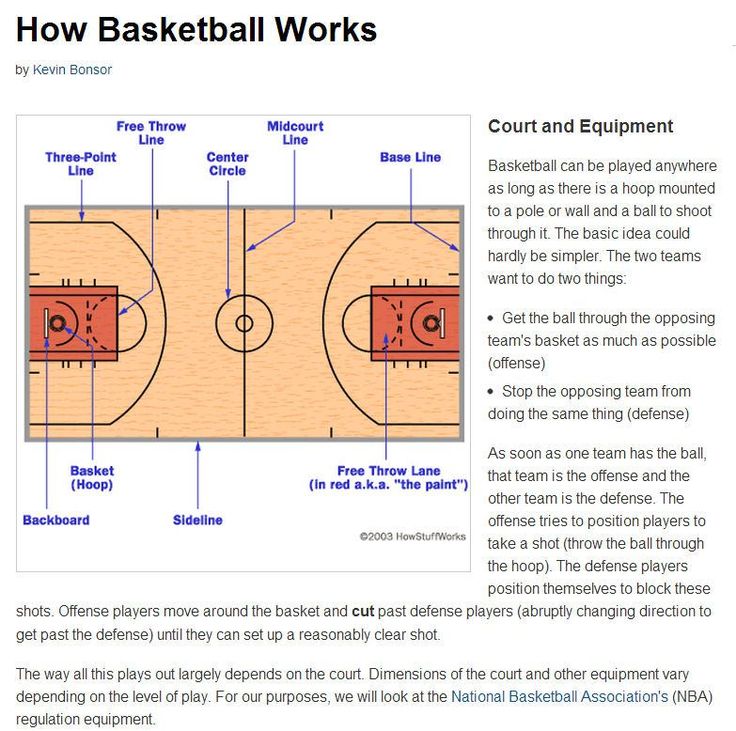
Deviations from the established minimum dimensions (26 m long and 14 m wide) are not permitted.
If your court is less than 26 meters long and 14 meters wide, it will not be suitable for professional competition. The same applies to fields that are over 28 meters long and over 15 meters wide.
Height requirements for basketball courts
The room where the basketball court will be located must be high. The ceiling must be at least 7 meters above the floor. If it is low, then it is not worth creating a basketball court in such a room. Because it will be unsuitable for professional games.
Basketball Court Lighting Requirements
The area where you plan to place the basketball court must have good lighting.
Each part of the field must be highlighted. And it's equally bright. So that the players of both teams can see the baskets, the posts and each other. Otherwise, they will collide during the competition.
The light on the basketball court should not be too bright either. Otherwise, he will blind the athletes. And also prevent the referees from watching the game.
What lines should be on the basketball court?
Each basketball court must be marked. It is important that each part of the site is marked with the same color paint. Preferably white.
Each marking line drawn on the field must have the same dimensions. Its width must be at least 5 centimeters.
That is, it should not be so that in one part of the field the marking lines are "thick". And in the other they had a small width.
The marking lines must be clearly visible to the players and referees. If you do not draw them brightly enough, then it will be impossible to play on such a basketball court. It will not be allowed to be used for competition.
What should the front and side lines be?
The edges of the basketball court area behind the baskets must be marked with 2 front lines.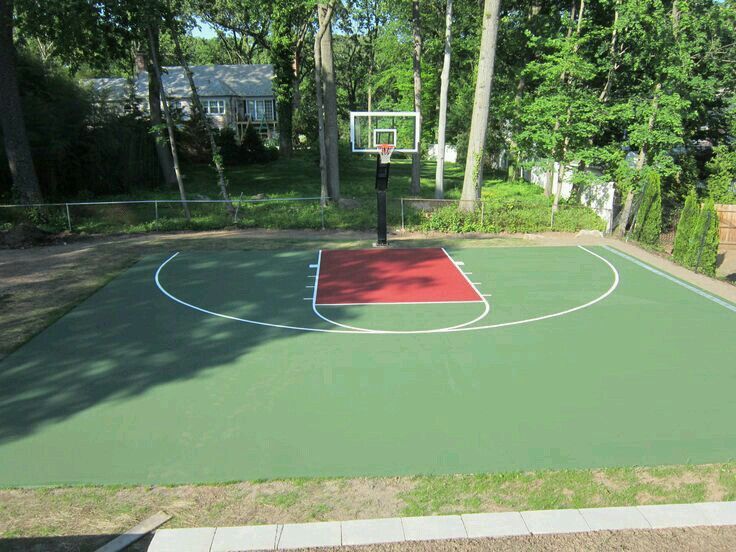
The areas of the field, which are located along the length of the court, must also have marking lines. They are called lateral.
As we have already said, there should be no foreign objects on the site. We are talking about tables for judges. As well as benches for spare players.
If you plan to place the substitutes' bench, this must be done off the field. At a distance of at least two meters from its edges. The same applies to referee tables.
Where is the center line drawn and how is it drawn?
The central part of the basketball court must also have markings. It must be drawn in the middle of the field.
The center line starts from the side lines and runs to the center.
It may protrude slightly from the side of the field. But no more than 15 centimeters.
What should the free throw lines be?
In the area of the zones with basketball baskets of both teams, a special area for free throws is drawn.
It must be located at a distance of 5.8 meters from the left side of the field. The penalty area line must be at least 3.6 meters long.
For a free throw, the basketball player will stand in the middle of this area.
Restricted areas
Each basketball field has special "restricted areas". They are highlighted with special "front" marking lines. And also outlined by lines for free kicks.
Additional lines are drawn from the front marking lines in the restricted area. They go in different directions.
Front lines must be placed three meters from the penalty area.
The front lines are part of the special restricted areas. They can be painted in different colors. However, the marking lines must match the hue of the circle that is drawn in the central part of the field.
More about free throw areas Free throw areas are also classified as restricted areas. on the basketball court they are deliberately increased.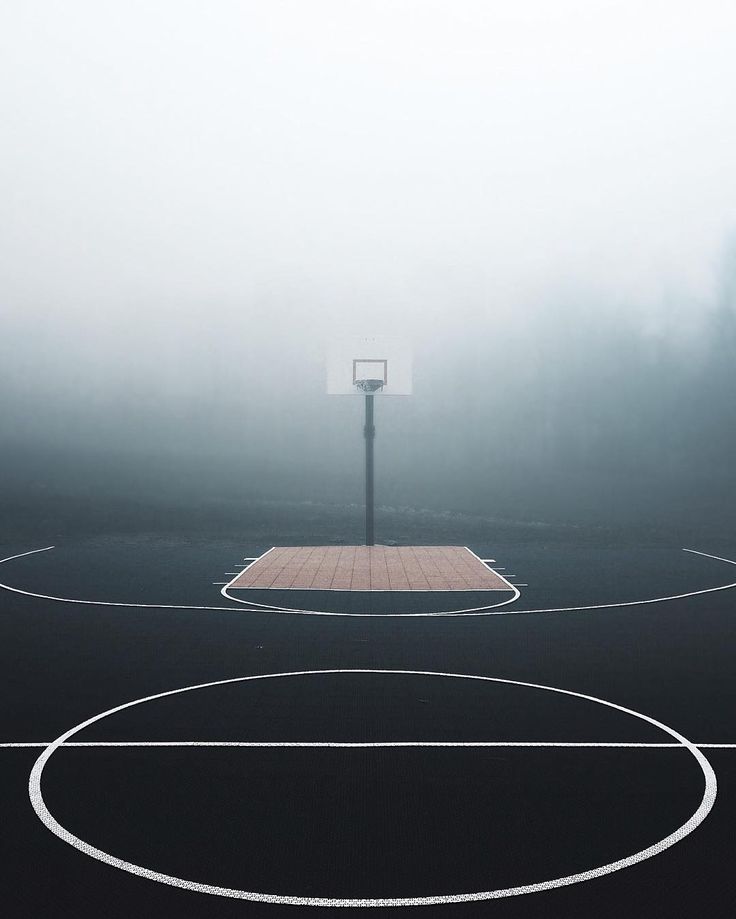 Semicircles of marking are placed next to them, the radius of which is 1.8 meters.
Semicircles of marking are placed next to them, the radius of which is 1.8 meters.
After that, a dotted line is drawn in the circles. They outline the inside of the penalty area.
In the picture below you can see the penalty areas. Players shoot for the basket in these areas.
How should the center circle be marked?
A circle must be marked in the center of the basketball field. Its radius must be at least 1.8 meters.
The color of the circle must be the same as the bounded areas.
3-Point Shooting Area
Basketball players can shoot 3-point balls from almost anywhere on the court. Except the one next to the basketball hoop.
2-Point Shooting Area When athletes shoot balls into the opponent's basket from next to it, the team is awarded two points. The area next to the opponents' ring is also classified as restricted.
The area around the teams' basketball hoops has 2 marking lines. They are placed parallel to each other.
They are placed parallel to each other.
The 2-point zone is next to the player's team's basket. In the area that is opposite the zone with the ring of the second team.
The 2-point zone is located 6 meters from the center line of the field.
Also, the area for a two-point shot is limited by a special circle. Its radius is 6.25 meters. When a player enters this zone, his goals are classified as two-point goals.
On successful throws from outside this area, the team receives 3 points.
In the picture you can see the areas of the field where shots are classified as three points.
If a player throws the ball from the central and side zones, he brings the team 3 points.
What should be the bench areas?
Players from both teams are allowed on the basketball field. However, not on the site itself, but outside it.
You need to place a shop for players in a special area. It should be highlighted with a special white line.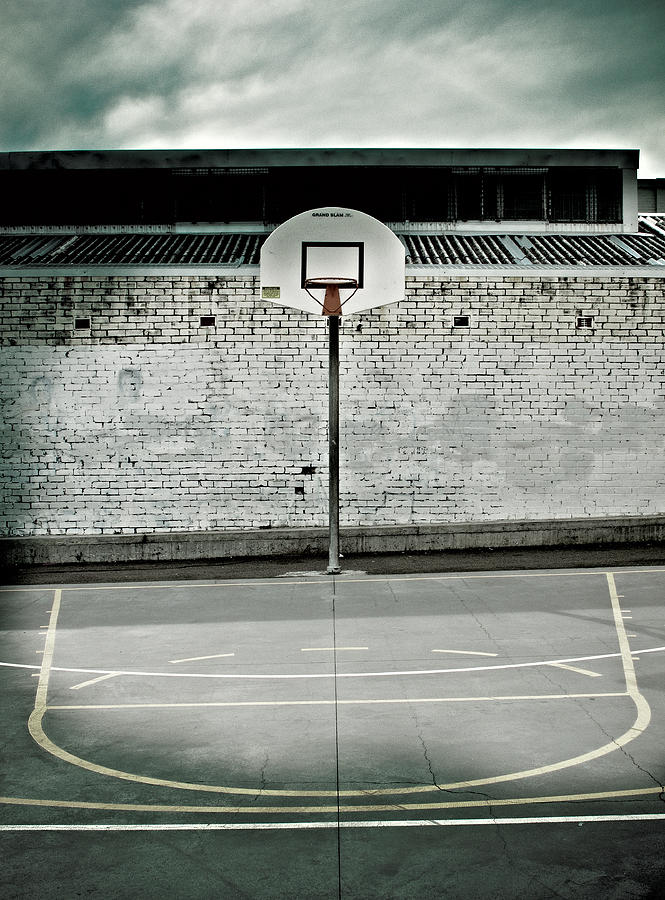 And be outside the field of play.
And be outside the field of play.
The length of the markings for the players' bench must be two meters. And the width is 5 meters.
Outline the team bench so that all players can see where people are sitting. And did not encounter them during intensive movements across the field.
Where should substitute players sit?
Athletes preparing to change players must sit between the team benches. Replacement basketball players must sit on special chairs.
Seats should be small. And do not stick out during the games. Otherwise, it will interfere with the teams on the field.
Substitute placement rules have been developed by the International Basketball Federation. They must be observed without fail when building a basketball court. Otherwise, you will not be allowed to compete on it.
What should be the place for judges?
Your task is to make sure that the judges have the most comfortable seats.